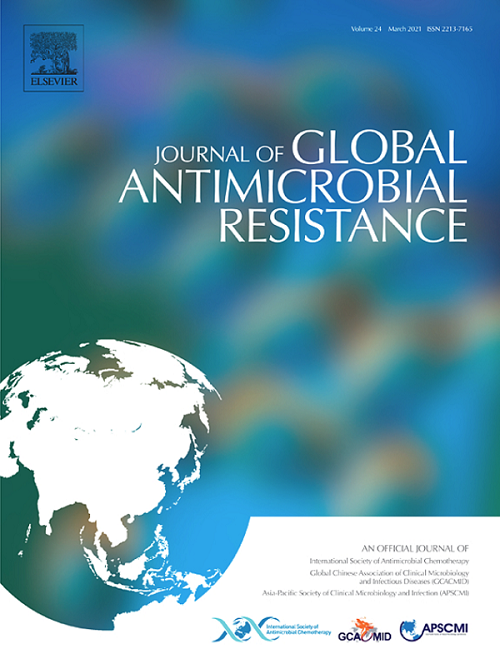首次在哥斯达黎加发现携带blaIMI-4碳青霉烯酶的罗根坎皮肠杆菌和四川肠杆菌
IF 3.7
3区 医学
Q2 INFECTIOUS DISEASES
引用次数: 0
摘要
目的哥斯达黎加国家细菌学实验室网络中获得的所有耐碳青霉烯革兰氏阴性细菌分离株均常规提交国家细菌学参考中心,由国家实验室对其碳青霉烯相关耐药机制进行监测和表征。作为卫生保健相关感染监测的结果,研究了两种碳青霉烯类耐药性机制未知的细菌分离株。方法采用Illumina和Oxford Nanopore技术对分离菌株进行分类鉴定、药敏试验、全基因组鉴定和生物信息学分析。结果分离株经鉴定为罗根坎氏肠杆菌和四川肠杆菌。虽然两株菌株的耐药谱不同,但均对碳青霉烯类耐药,改良碳青霉烯类失活法(mCIM)阳性,硼酸对碳青霉烯类耐药有抑制作用。对分离株基因组的全面表征显示,在25 kb的整合移动元件中插入了罕见的blaIMI-4基因,与EcloIMEX-2密切相关。blaIMI-4变异在全球范围内的有限分布,以及在哥斯达黎加整合移动元件内的两种不同细菌中被鉴定出,强调了使用下一代测序技术进行常规抗生素耐药性监测的迫切需要。这项研究表明,这种做法可以及时发现新的或罕见的抗生素耐药性机制。本文章由计算机程序翻译,如有差异,请以英文原文为准。
First identification and whole-genome characterization of human-associated Enterobacter roggenkampii and Enterobacter sichuanensis carrying blaIMI-4 carbapenemase in Costa Rica
Objective
All carbapenem-resistant Gram-negative bacterial isolates obtained in the Costa Rican National Network of Bacteriology Laboratories are routinely referred to the National Reference Center for Bacteriology for the national-laboratory for the surveillance and characterization of their carbapenem-related mechanism of resistance. As a result of this healthcare-associated infection surveillance, two bacterial isolates with unknown mechanisms for carbapenem resistance were investigated.
Methods
The isolates were subjected to taxonomic identification, antimicrobial susceptibility testing, and whole-genome characterization, using Illumina and Oxford Nanopore technologies, and bioinformatic analyses.
Results
The isolates were identified as Enterobacter roggenkampii and Enterobacter sichuanensis. Although the isolates presented different antimicrobial resistance profiles, both were resistant to carbapenems, positive for the modified carbapenem inactivation method (mCIM), and showed inhibition of carbapenem resistance with boronic acid. The full characterization of the isolates’ genomes, revealed the presence of the rare chromosomal blaIMI-4 gene inserted within 25-kb integrative mobile elements, closely related to EcloIMEX-2.
Conclusions
The limited global distribution of the blaIMI-4 variant, along with its identification in two distinct bacterial species in Costa Rica within integrative mobile elements, underscores the critical need for regular antibiotic resistance surveillance using next-generation sequencing technologies. This study demonstrates that this practice allows the timely detection of novel or rare mechanisms of antibiotic resistance.
求助全文
通过发布文献求助,成功后即可免费获取论文全文。
去求助
来源期刊

Journal of global antimicrobial resistance
INFECTIOUS DISEASES-PHARMACOLOGY & PHARMACY
CiteScore
8.70
自引率
2.20%
发文量
285
审稿时长
34 weeks
期刊介绍:
The Journal of Global Antimicrobial Resistance (JGAR) is a quarterly online journal run by an international Editorial Board that focuses on the global spread of antibiotic-resistant microbes.
JGAR is a dedicated journal for all professionals working in research, health care, the environment and animal infection control, aiming to track the resistance threat worldwide and provides a single voice devoted to antimicrobial resistance (AMR).
Featuring peer-reviewed and up to date research articles, reviews, short notes and hot topics JGAR covers the key topics related to antibacterial, antiviral, antifungal and antiparasitic resistance.
 求助内容:
求助内容: 应助结果提醒方式:
应助结果提醒方式:


